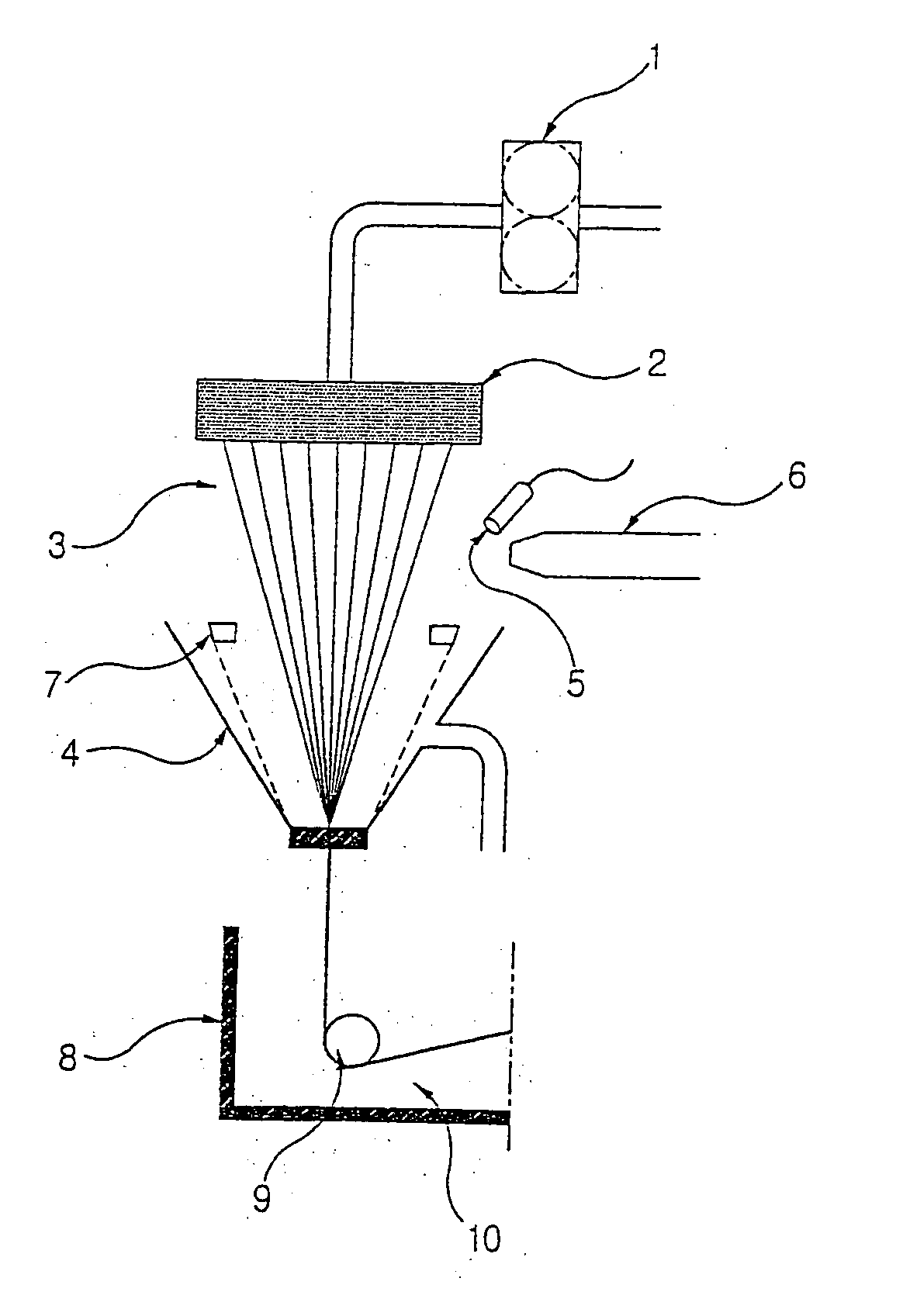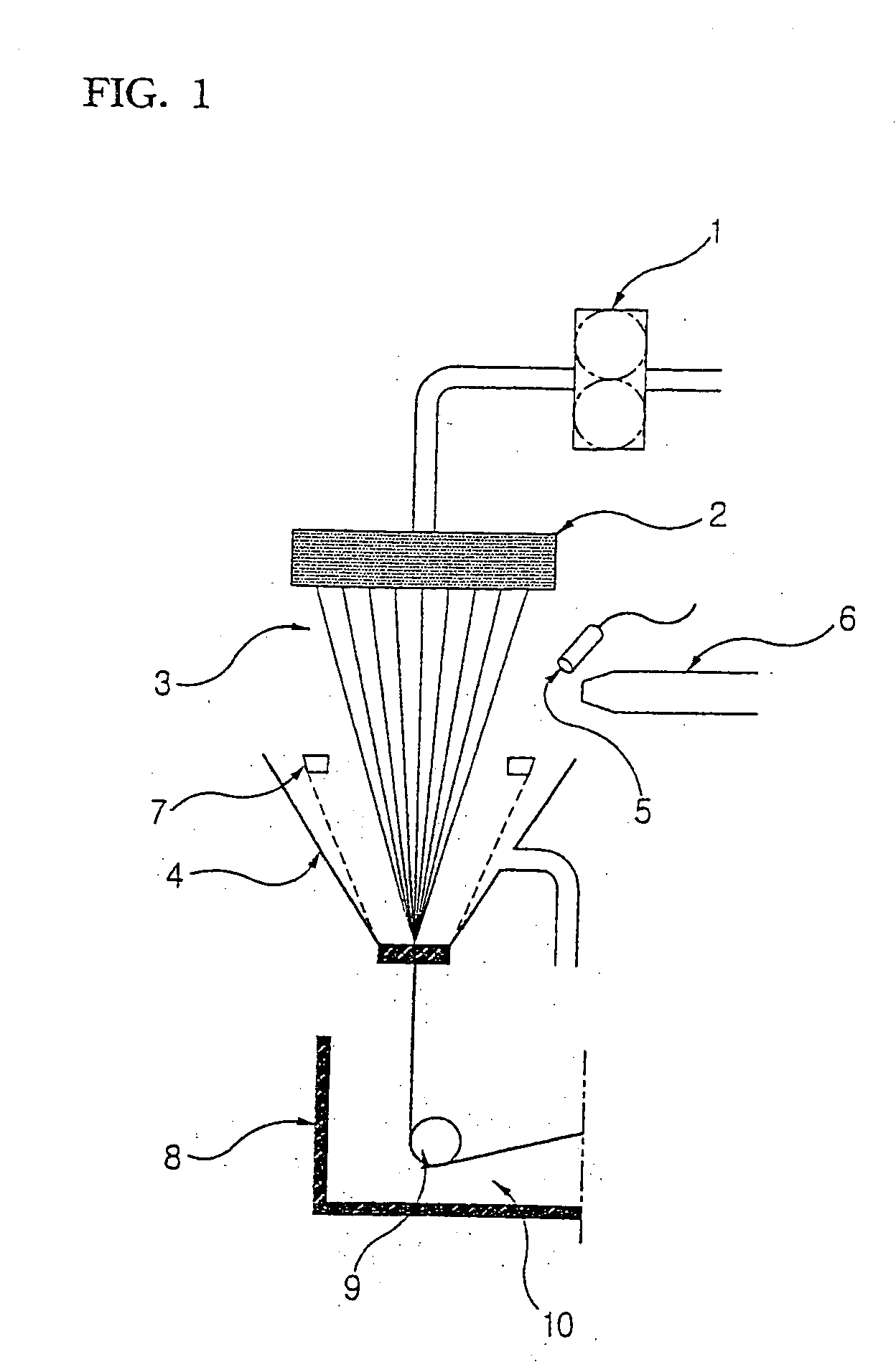Lyocell multi-filament for tire cord and method of producing the same
a technology of tire cords and lyocells, which is applied in the direction of tyre parts, woodworking apparatus, textiles and paper, etc., can solve the problems of difficult to control moisture and quality of tires, low tenacity of cords, and inability to have all the above excellent physical properties, etc., to achieve excellent tenacity and modulus, improve driving stability, and improve uniformity of automobiles. uniformity and dimensional stability
- Summary
- Abstract
- Description
- Claims
- Application Information
AI Technical Summary
Benefits of technology
Problems solved by technology
Method used
Image
Examples
example 1
[0067] Mixed powder in which pulp with the degree of polymerization (DPw) of 1200 containing a α-cellulose content of 97% is mixed with PVA in a weight ratio of 20:1, NMMO.1H2O and 0.01 wt % propyl gallate were mixed to produce an 11.5% cellulose solution. Spinning nozzles with a diameter of 120 mm including 800, 1000, and 1200 orifices were used to extrude the cellulose solution. At this time, a diameter of each of the orifices was 150 μm, and a ratio of a length to the diameter (L / D) of each orifice was 4 for 10 all the spinning nozzles. When the cellulose solution (head temperature: 110° C.) passed through the spinning nozzle flew through air gaps at a point spaced apart from the spinning nozzle by 50 mm, cooling air with a temperature of 20° C. and relative humidity of 40% blew at a speed of 4 m / sec to the solution, and an extruding amount and spinning speed of the solution were controlled in such a way that fineness of the resulting multi-filament was 1500 to 2000 deniers. A te...
example 2
[0069] First mixed powder in which pulp with the degree of polymerization (DPw) of 800 containing a α-cellulose content of 97% is mixed with PVA in a weight ratio of 20:1, second mixed powder in which pulp with the degree of polymerization (DPw) of 1200 containing a α-cellulose content of 97% is mixed with PVA in a weight ratio of 20:1, NMMO.1H2O, and 0.01wt % propyl gallate were mixed to produce two different cellulose solution samples. In this regard, a concentration of the cellulose solution including the pulp with the degree of polymerization of 800 was 13.5%, and that of the cellulose solution including the pulp with the degree of polymerization of 1200 was 11.5%. Spinning nozzles with a diameter of 120 mm including 1000 orifices with three types of diameters of 120, 150, and 200 μm were used to extrude the cellulose solution. At this time, a ratio of a length to the diameter (L / D) of each orifice was 5 for all the spinning nozzles. Cooling air was fed to air gaps according to ...
PUM
| Property | Measurement | Unit |
|---|---|---|
| diameter | aaaaa | aaaaa |
| length | aaaaa | aaaaa |
| length | aaaaa | aaaaa |
Abstract
Description
Claims
Application Information
 Login to View More
Login to View More - R&D
- Intellectual Property
- Life Sciences
- Materials
- Tech Scout
- Unparalleled Data Quality
- Higher Quality Content
- 60% Fewer Hallucinations
Browse by: Latest US Patents, China's latest patents, Technical Efficacy Thesaurus, Application Domain, Technology Topic, Popular Technical Reports.
© 2025 PatSnap. All rights reserved.Legal|Privacy policy|Modern Slavery Act Transparency Statement|Sitemap|About US| Contact US: help@patsnap.com


